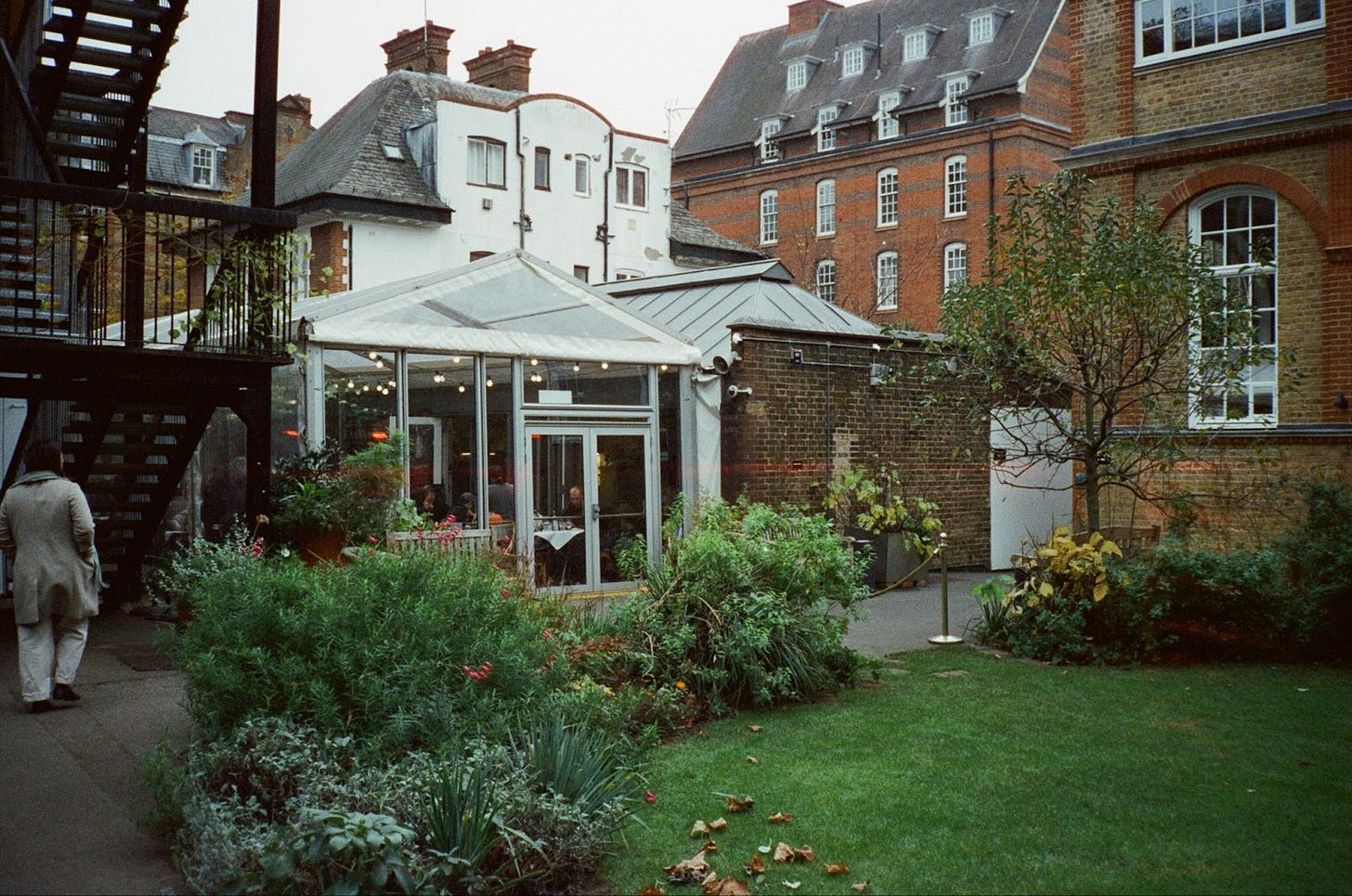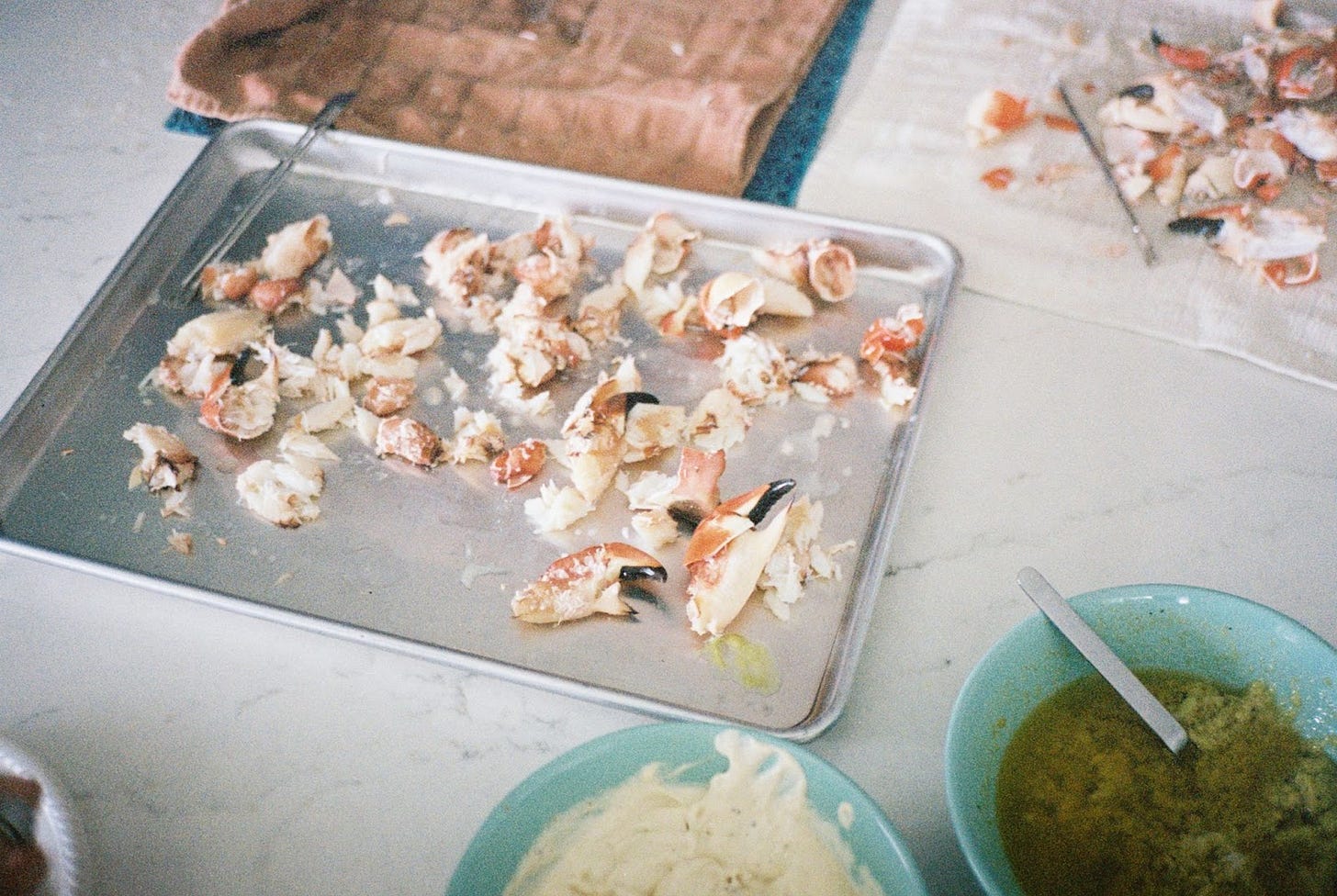Restaurant are supposed to make people happy
The scene inside a few good spots, where dining out isn’t all that broken
No restaurant has perfected the dessert course quite like Wildair did in 2016. It was simple: one chocolate tart and one panna cotta. Both must-orders. Pastry chef Fabián von Hauske seasonally would rotate through featured fruits in the panna cotta, and different presentations of the tart. (Eventually, and unintentionally, the kitchen made the tart look like the poop emoji, to significant success).
There were few better ways to end a New York evening than swinging by this small gem on Orchard Street, letting the staff pick a bottle of wine for you and then giving in to Fab’s creations. More than anything, it made people happy, which was the point.
Fabián recalls in Wildair’s cookbook being 23 years old, four months into opening Contra, his first restaurant, and awaiting an early review with terror. When it landed over the holidays, it was mostly positive. But the desserts were singled out as the worst part of the meal, at one point being compared to “a horse’s breakfast.” Fabián looked back at his complex creations — a semi-oxidized apple granita, toasted oats, and caramelized bits of chewy apple — and it got dark.
“There was this feeling I couldn't shake, knowing I did something wrong and also knowing it was clouding my judgment, making me question everything.”
But then he shook it off:
“I remembered a thing my former boss Johnny luzzini told me once, that desserts need to make people happy. You could (and should) be creative, but their main purpose in the meal is to make people happy. I realized that creating a dessert just to make people think or make them question something about a certain dish wasn't enough for me anymore. If the desserts weren't actually making people happy, if people weren't truly enjoying them, what was the point?”
I’ve been thinking about this moment a lot over the past six months while dining out in cities from Los Angeles to New York to London. Friends I trust in food keep saying that something is broken, especially at popular American restaurants in major cities. That actually most restaurants are bad. That unless you have an expense account and a maitre d's phone number, you should just buy a cookbook and stay home.
I don’t agree. Things are bad at plenty of places, but they’ve always been that bad in some form. As you poke around at the right spots, you’ll find that they are doing what worked for Fabián and the crew at Wildair. They’re making people happy.
When I was the same age as Fabián reading that review, I used to box-check restaurants. Hitting apparent hot spots and ordering as much as possible without prioritizing the experience or the company. I had a take, but not a memorable meal.
Eight years later, my dining-out approach and expectations have flipped. I like when the food is exciting or surprising. But mostly I just want a restaurant that cares about my evening, assuming I come in open-minded and meet it halfway. Here’s a list of places that have done that most successfully lately, in a number of different ways.
My favorite meal
Demo | NYC
This new wine bar’s chef, Q, instilled a lot in me during my year cooking for him, but the biggest lesson went back to Fabián’s desserts: The best chefs and the best restaurants are focused on making diners happy. Nothing else really matters. All the focus on technique, creativity, craft and consistency is rooted in ensuring a customer loves their time in your space from start to finish. When friends or fellow cooks come in, you take care of them with the proper touches, like a glass of sparkling wine or a dessert tasting. When you’re deep in the weeds and you want to cut corners, you remember that a stranger might be tasting that dish for the very first time, and you get back on track.
Q’s former restaurant, Cool World, closed because it never really accomplished this mission. Demo, which opened up in February, already does. Some (rather biased) highlights:
The space makes sense, and it’s buzzing without trying too hard. Cafe and bar up front, tables and counter service in the back. Relatively bare decorations, but beautiful touches. (The flowers on each table are great).
You can trust the staff to guide you through a reasonably priced wine list that makes sense.
There are five have-to-try dishes: Focaccia with anchovies and cultured butter, a crab casino using Ritz as crunch, a whole lobster au poivre Q has been perfecting for years, the banana pudding, and most memorably, Dina Fan’s arroz a la plancha, which I’ve heard described as what mac and cheese should taste like after three Rose Delights. The food is comforting but exciting. Q is one of the most creative people I’ve ever met. But he’s honed his menu to get the job done, and make you want to come back.
Here’s the thing about restaurants: They’re always teetering on the edge of failure. If one cook calls out — and they will — you’re screwed. If your floor captain is in a foul mood, everyone in the dining room might hate their meal. If your design is a little off, you might never fill up. The idea that the food is primary is a fallacy. Is the food at Demo better than the food at Cool World? Yeah, a bit. But it’s better because it feels complete.
The best restaurants aren’t so well-oiled that nothing ever breaks. Instead, they’ve worked through every bad potential outcome and know how to prevent you from noticing it. The front and back of house staff make sure you never see the new fire. Or they’ve built up enough good will to make you forget it.
It takes a rare magic to keep all of those balls in the air. But Demo does it. All the details are right. I can’t wait to go back.
I don’t know, I unfortunately don’t live in London, but I was ruined by a week’s worth of dining out here in December. I left telling everyone who asked that it’s a better dining out city than New York. I still believe it, for a few reasons:
Everyone is nice and happy to have you at their restaurant. Like, I’m sorry, but this matters. Jamie Smart excitedly walking each dish to your bar stool at Cadet after he finishes plating on his tiny station. Asma Khan finding the right moment in between courses at Darjeeling Express to ask about your trip. The staff at Rochelle Canteen encouraging you to linger in their perfect space for hours. It stays with you.
Everything is perfectly seasoned and perfectly cooked. Maybe I got lucky, but the level of execution at restaurants across London knocked me out. It made it easy to surrender to whatever sounded good that night, rather than following some digital what-to-order guide.
The spaces have personality and a point of view.
I didn’t have to send any texts or DMs to get these reservations.
The restaurants’ tagged pages on IG (mostly) aren’t flooded by irritating Reels.
A few perfect dishes
Soban & Mariscos Jaliso | LA
At Soban, we ordered the braised short ribs and the soy-marinated crab. They brought the black cod instead of the crab. We didn’t say anything. It didn’t matter. This place has three perfect dishes and we got two of them.
At Mariscos Jaliso, I got to introduce someone to their shrimp taco, my favorite bite of food in the world. It’s a great feeling, watching their eyes bug out in excitement over on Olympic Blvd, while feeling the satisfaction of this dish remaining as good as ever.
Reliable classics
Birdie’s | Austin
More and more, my favorite kind of dining out experience. Some staples — soup, salad, tartare, pasta, steak, all the desserts — executed well in a beautiful space with a lovely playlist. This place has become a little easier to get into, which is a delight.
Three trustworthy tasting menus
I recall a few of the dishes — the fresh BBQ tempeh at HAGS, the three-course tuna sampler at Yoshino, the black cod with lemongrass and buttermilk at Baroo — but mostly I’m reminded of the smaller touches. Mina Park’s wonderful service and gossiping with my friend Sean at Baroo in between dishes. Polaroids and post-service pizza with Telly Justice at Hags. Tadashi Yoshida joking around and making everyone at Yoshino relax a bit.
And then there was the way I felt when I called the Uber home. Light, full enough, ecstatic, thinking about the company and the time more than the progression of courses. Maybe that’s an absurd desire for meals that range from $150 to $500 per person. But I’m good with it. This is the way in which I like to splurge. And food supplements the experience rather than makes it. That’s fine. I would gladly make annual trips to any of the three before I tried another new tasting menu spot. They’ve earned that trust.
And I wouldn’t go in expecting the best meal of my life, a goal that can’t be reached, since those have all been at a home. Any Thanksgiving cooked by my family in Louisiana or Staten Island. A few New Year’s Eve potlucks. Family meals at Cool World. A week of cooking in East Hampton. A Valentine’s Day spent at home with multiple courses and lots of wine.
The food tastes better. The company is more intimate. The memories are more intense. I don’t need a restaurant to deliver that. It can’t. I just need it to be a restaurant that prioritizes the right things. And I prefer the ones that execute on a high level, with thoughtful service, sexy rooms and good people. I’m grateful for all of these that have figured it out.
A few Saturdays ago, my partner and I flew back into New York after a week away and were craving Torrisi. I don’t have an in at Major Food Group, so we did the deeply embarrassing move of standing in the cold from 4:45-5:15, going to see Madame Web (incredible) then returning at 9pm for dinner. A couple bros who lived down the street were telling everyone else in line when they could expect a table based on the extensive algorithm they’d developed in their heads from months of experience. I spent the entire wait refreshing Resy, trying to save myself.
It was worth it. There are few better meals in New York right now than getting into the dining room of this place and ordering the clam boule, the ham and zeppole, the cucumbers, a pasta, the duck and every single dessert. We left happy.
But this whole thing is kind of ridiculous. Here’s Jason Stewart putting it better than I can:
The reason I eat at home most days is that you can’t just go to a great restaurant nowadays; you have to plan it weeks in advance, even as a micro-influencer. It’s fun looking forward to a big red heart drawn on the kitchen calendar, but it becomes exhausting, and it is truly easier to make my own congee at home.
It’s annoying for diners, and it’s inefficient for business. Even places like Torrisi need a better way to make money off of this high demand, something that’s trickier in restaurants than any other industry. I could’ve secured a prime Torrisi reservation by committing to spending at least $300 per person via Dorsia. Or I could do a better job of becoming friends with the MFG hosts. Instead, I stood in the cold. I’m a sucker.
But — free, tangential, and yet again biased idea — if I ran a busy restaurant like Torrisi, here’s what I would do:
Set up a Substack site at newsletter.torrisinyc.com or club.torrisinyc.com
Import your existing mailing list. Keep using this for events and stuff, but also use it as more. Turn on paid subscriptions.
Get your team to post something cool at least once a week, like a recipe or a behind-the-scenes essay. Maybe you even hire a food journalist to run the content operation.
People will start paying for the content and to be part of the community, the same way they do for other Substacks. You can use your CRM to better track paid subscribers as VIP regulars. And you can also bake in additional perks where you take advantage of your demand, like …
Setting your founding tier membership to $500 or $1,000 a year. Founding tier members get exclusive access to a monthly or quarterly reservation, PX treatment, events and whatever else you want to offer.
(Last tangent: It’s true that people underestimate how effective being friendly with hosts and servers can be if you want an in at a hot restaurant. But the thing I learned early on as a line cook is that nothing really goes as far as showing up with a stuffed bodega bag for the kitchen team. A busy service can kick your ass. Having a friendly customer drop off a stash of candy, big ass Gatorades and the promise of a Pacifico gives you extra life when you’re breaking down your station while reeking of fryer oil.)
“Wait, what’s up with the frogs?”
“We just got them in today!”
The staff at Frog Club is explaining to our table that they’re doing this new thing at the big circular booths where, if you’re not using all of the chairs, they’ll come up to you at the start of the meal and say, “Oh, looks like the rest of your party just arrived.” And then they’ll place two child-sized frogs in the empty seats.
“I love it here. It’s like the Rain Forest Cafe.”
It’s our second time in. I’ll let Matthew Schneier recap the deal:
Frog Club is reservation-only, by email, and that email address has, after a short time of semi-public availability, been removed from the restaurant’s website … (it) wishes to 86 the uninvited in advance, which has naturally made it one of the hottest reservations in town. (This, and the whiff of notoriety, that chef Liz Johnson brings with her — she was one of the married partners of L.A.’s Horses, the site of l’affaire des chats.) The memes are percolating. Nolita Dirtbag compared it to Señor Frog’s. The night I went, Ryan Murphy was holed up at a table on one side of the room with a few friends; at the other, an old, L.A.-based friend of mine celebrated the day’s announcement that she and Kim Kardashian had sold a thriller, with Kim to star, to Amazon after a five-way bidding war.
Also, they put branded stickers on your phone’s cameras. I, frankly, have loved both reading about and visiting this new spot in the West Village. I also loved Liz’s food at Mimi and Horses, fitting that Birdie’s mold of everything I want to eat.
The freak out has been entertaining, but consider the other way that Frog Club could have opened: Given the team involved, reservations for the opening weeks disappear as soon as they pop up on Resy. Rather than get to work out the kinks and facilitate more of a 50/50 split between newcomers and regulars, it’s a free-for-all, bot-induced nightmare. There are TikTokers and pictures and flashes. The ambiance gets lit up. The tagged page on IG is torched.
So, hot take, I respect this approach. The restaurant gets to wrestle back some control while building up demand. And despite the theatrics, once you’re in, you feel taken care of. Service is great. The cosmo and the razzle-dazzle of desserts, in particular, are stellar. I like the lobster pierogis, burger and spinach soufflé. This place has a point of view — a somewhat wild point of view, but, still, a distinct one that felt more homey on a second visit.
That perfect restaurant alchemy is perhaps teetering a bit more here than at Demo. On our second visit, some savory dishes had me wishing for salt, something I didn’t experience at Mimi or Horses. But it’s early. And that wasn’t the case for Round 1. Things happen during a restaurant’s first month within a small sample size.
The back of the dessert menu at Frog Club features an essay with the line, “Here, the customer isn’t always right.” And we’re not. Expectations are out of whack.
A few hours after leaving Frog Club, Michael Imperioli stared me in the face.
“It’s going to be okay. Stay calm. Don’t worry.”
I’d been ushered to the stage with a few other audience members for a scene in the middle of Amy Herzog’s Enemy Of The People. Jeremy Strong was towering over me, screaming, close to breaking down, his character pleading for someone to listen to him. It’s a moving, emotional, special performance. Seeing it up close was stunning. It’s still ingrained in my head.
That’s not a moment or feeling a restaurant can or should try to reach. Restaurants should make you happy and comfortable, connected to the friends at your table and the people working there through the food, the service and the room. I’ve lost all desire to have it be a show that blows me away, and I think that expectation is misguided. Most restaurants are bad, sure. But some of them are good. A few are even great. That greatness takes a near-impossible magic. But they’re out there.






